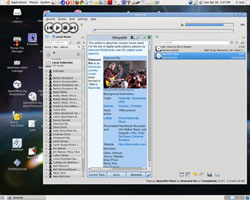
Linux provides more than one way to listen to music collections. Thebare-bones solution is to click on a music file from within a filemanager app. The high-end approach is to playback music with Amarok.
Amarok is a sound-system-independent audio player with a flexibleinterface that uses a browser-like design. Amarok does what a simplefile manager cannot do. It lets you create playlists to maximize yourmusic listening activities.
The latest version, Amarok 2.3.0, was released on March 15. Itcontains enough improvements over version 2.2.2 that it well deservesanother look if you tried it earlier and did not like it.
The new interface is highly configurable. This unlocked layout makesAmarok a good choice on small screen laptops and netbooks.
Amarok now runs in tabbed mode. Or better yet, unselect Lock Layoutfrom the View menu. This lets you close or move any of the panels andthe toolbar.
Needed Switch
I started using Amarok when I switched to the Ubuntu Linux desktop. Iwas happy with the performance of version 2.2.2 compared to analternative app, Listen.. Listen is verysimilar to Amarok, but Amarok has a slightly better feature set.
Amarok is written for the KDE environment; Listen is the Gnomeenvironment equivalent. While Ubuntu is native to Gnome, Kubuntu isthe KDE version.
So unless you run Kubuntu or another KDE-based Linux distro, a littlefinessing is needed to get Amarok to run on the Gnome desktop. It’snot complicated to do — just add the missing libxine1 library packageto get sounds to play.
Do this with the following command entered into a terminal:
>
This will add to your system the MPEG-related plug-ins used bylibxine1. This includes the media player library the Xine engine usesand the ffmpeg plugin for Xine to access audio and video codecs.
Worthy Update
I was impressed with the high level of improvement built into version2.3.0. The earlier version was fine as it was, but this latest versionis well worth the upgrade.
One big change is the performance optimization. The Playlist is muchfaster, and the process of fetching cover images works much better.
Version 2.3.0 has some nice new features such as the AutomatedPlaylist Generator, a Similar Artists and Upcoming Events finder andbetter support for podcasts and saved playlists.
Other Features
Amarok sports a new main toolbar and a file browser that is muchsimpler to use. I liked the slim toolbar used in the previous version; that’s still in version 2.3.0 as a drop-down option.
Clearly, I like the new look and feel of the file browser. It makesuse of breadcrumb navigation, so it is much easier to track where I’vebeen within my music collection and return there.
Another feature that is easy to like is the context menu of tracks inyour playlist. It now has the ability to show media sources. This isa handy way to return to the same track in the collection browser forediting, moving or deleting the file.
Podcast Podunk
I spend considerable time listening to podcasts as a source of news. Amarok doubles as my app of choice for managing podcasts.
Amarok makes it easy to change the update interval and the locationto store newly added files. I can save podcasts grouped by source.
Also, I can merged views the same as I can with any other local musiccollection. When a new source of podcasts is available, Amarok turnsoff the merged view and instead shows a collapsible list of the newlistening sources.
Managing podcast collections could not be easier. I can drag and droppodcasts and podcast channels to add them to the device or service.
More Key Features
Amarok is a pretty slick music playing package. Its library runs on abuilt-in light version of MySQL. Plus, it supports multiple backendssuch as GStreamer, xine, NMM, MAS (media application server) and aRts.
The 10-band equalizer cranks out an awesome sound quality. It islimited only by the richness of the computer’s speakers.
Cover art is automatically downloaded from Amazon services. Fulllyrics are a click away as well.
Layout Rocks
Much of the new interface is easy on the eyes. The screen is dividedinto three primary viewing panels. The media sources section is thefile manager for navigating to the hard drive tree, Internet sourcesor the local collection. The second section is the playlist panel. Thecenter section is the context panel.
Within the context panel is the choice of viewing the current track,the lyrics or the Wikipedia information extension. Clicking one of thethree tabs at the bottom of the viewing panel switches the content.
Across these sections on the top portion of the screen is the playerprogress bar. Two buttons at either end of this progress bar provideinstant access to play/pause and volume settings. All of the audiocontrols are accessible from the drop down Amarok menu.
Control Central
All program options are reached from the other drop-down menus. Theseprovide access to View, Playlist, Tools and Settings.
Don’t look for much help, however, That drop-down category just tellsyou about the program. For first-time users, some basic quick startsteps would be a big help.
Additional file management tools are nestled in the right-click menus.The options change based on whether the pointer touches an individualsong title or a full album. The choices range from editing anddeleting tracks to organization files and playlists.
Bottom Line
Amarok is one of the most integrated and complete music playingsystems available in Linux. What it contains is state of the art. Whatit does not offer probably is not found in any other program.
This package is well designed and easy to use. It has a link to theMagnatune.com online music store. But the purchase and synchronizationfeatures are not nearly as rigorous as options in Windows andMac-based platforms. So if you can’t exist without an iPod or Zune device tethered to thecomputer for musical replenishment, you will need a work-around.






















































